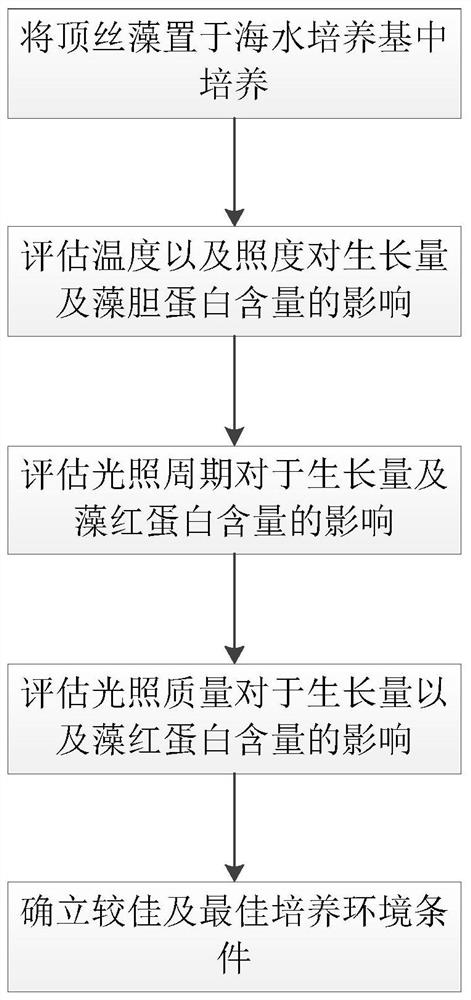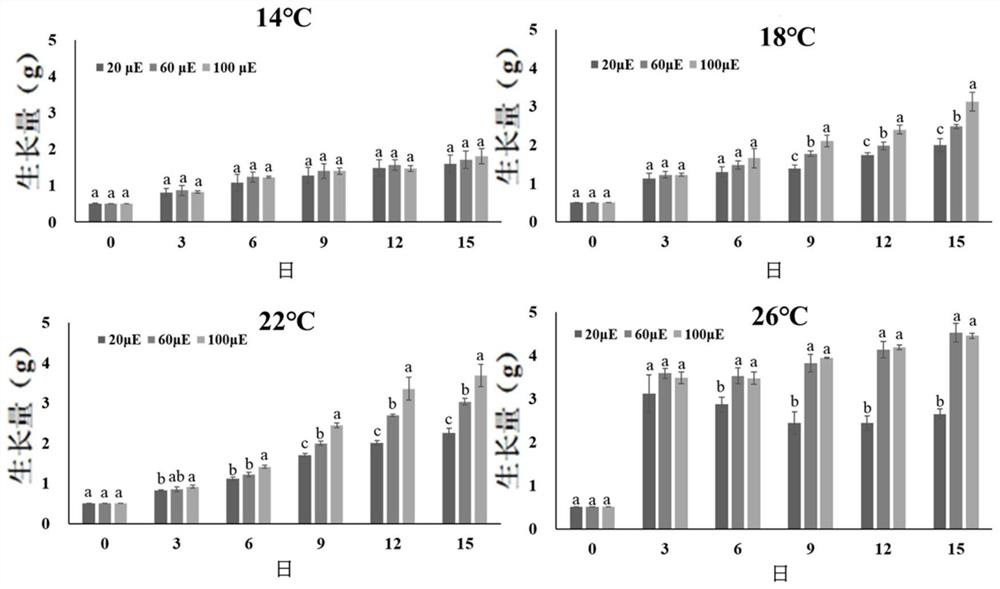Culture method for increasing content of phycoerythrin in acrochaetiaceae
A technology of phycocyanin in algae and a cultivation method, which is applied in the field of cultivation to increase the content of phycoerythrin in Acrestria, can solve problems such as wall-breaking extraction and separation procedures, achieve high phycoerythrin content and increase growth rate , the effect of increasing the content
- Summary
- Abstract
- Description
- Claims
- Application Information
AI Technical Summary
Problems solved by technology
Method used
Image
Examples
Embodiment 1
[0037] Acromega culture
[0038] Take 0.5g of Acrometrix algae with a wet weight and put them into a culture container containing 800mL of seawater medium, and cultivate them in a culture environment. During the culture, pump air so that the Acrometrix algae can roll in the culture container. Wherein, the seawater culture medium is natural seawater or artificial seawater, and the ratio of the Acromegae and the seawater culture medium can be adjusted according to actual needs; wherein, the seawater culture medium contains 1600 μL of nutrient salt, and the nutrient salt and the seawater culture medium The proportion can be adjusted according to actual needs; wherein, the nutrient salt contains 70 ~ 80g / L sodium nitrate (NaNO 3 ), 4~6g / L sodium dihydrogen phosphate (NaH 2 PO 4 2H 2 O), 25~28g / L ammonium chloride (NH 4 Cl), the nutrient salt preferably comprises 75.0g / L sodium nitrate (NaNO 3 ), 5.0g / L sodium dihydrogen phosphate (NaH 2 PO 4 2H 2 O), 26.8g / L ammonium chlor...
Embodiment 2
[0040] Evaluation of the Effects of Temperature and Illumination on the Growth and Phycobiliprotein Content of Acretaxel algae
[0041] Evaluation method: use the method described in Example 1 to cultivate Acrometrix algae, and set the culture environment as a fixed culture light cycle with different culture temperatures and culture illuminance, to understand the effect of temperature and illuminance on the growth of Acregothere algae and the growth of algae. Influence of bile protein content. Specifically, the culture light cycle is fixed as 12 hours of light and 12 hours of darkness (12L:12D); the culture temperature is set to 14, 18, 22 or 26 ° C; the culture illumination is set to 20, 60 or 100 μE ; Be divided into 12 groups (as shown in Table 1) altogether, every group 3 repeats. Change the seawater every 3 days during the cultivation and weigh it to make a record. When weighing, filter it with a 200-mesh plankton net, centrifuge at 2000rpm for 5 minutes to filter out th...
Embodiment 3
[0058] Evaluation of the effect of photoperiod on the growth and phycoerythrin content of Acretaxel algae
[0059] Evaluation method: use the method described in Example 1 to cultivate Acrometrix algae, and set the culture environment to a fixed culture temperature and culture illumination with different culture light cycles to understand the effect of the light cycle on the growth of Acrometrix algae and phycobilia. Effect of protein content. Specifically, the culture temperature was fixed at 22°C; the culture illumination was fixed at 100 μE; the culture light cycle was set to 8 hours of light and 16 hours of darkness (8L:16D), and 12 hours of light and 12 hours of darkness (12L:16D). 12D) or 16 hours of light and 8 hours of darkness (16L:8D); divided into 3 groups (as shown in Table 2) in total, with 3 repetitions in each group. Change the seawater every 3 days during the cultivation and weigh it to make a record. When weighing, filter it with a 200-mesh plankton net, cent...
PUM
| Property | Measurement | Unit |
|---|---|---|
| wavelength | aaaaa | aaaaa |
| wavelength | aaaaa | aaaaa |
| wavelength | aaaaa | aaaaa |
Abstract
Description
Claims
Application Information
 Login to View More
Login to View More - R&D
- Intellectual Property
- Life Sciences
- Materials
- Tech Scout
- Unparalleled Data Quality
- Higher Quality Content
- 60% Fewer Hallucinations
Browse by: Latest US Patents, China's latest patents, Technical Efficacy Thesaurus, Application Domain, Technology Topic, Popular Technical Reports.
© 2025 PatSnap. All rights reserved.Legal|Privacy policy|Modern Slavery Act Transparency Statement|Sitemap|About US| Contact US: help@patsnap.com



